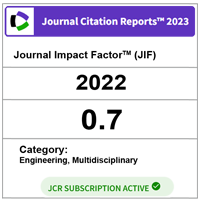SHAPE MEMORY INVESTIGATION OF SMART CAMAR LOGO USING NITI ALLOY WIRE
DOI:
https://doi.org/10.11113/jt.v76.5513Keywords:
NiTi alloy, shape memory effect (SME), X-Ray Diffraction (XRD), Phase Transformation Temperatures (PTTs)Abstract
This project is investigates of NiTi shape memory alloy for simple smart application. The shape memory effect (SME) is attributed from the reversible phase transformation when subjected to stress and temperature. In this study, a small model of CAMAR logo was designed to mimic the shape memory effect. Three samples of wire were investigated; (i) Austenitic NiTi (ii) Martensitic NiTi and (iii) commercial plain carbon steel. The reversible austenite to martensite transformation of the NiTi wire was investigated by a differential scanning calorimetry (DSC) at temperatures ranging from -50 and 200oC. The wire was shaped into CAMAR logo using a mould and then heated at 500°C for 30 minutes in a high temperature furnace. To observe the shape effect recovery, the wire was straighten and reheated in warm water at different temperatures. Results showed that the austenitic wire exhibited complete shape memory recovery after heated at temperature approximately 35°C and  80°C. For the martensitic wire, complete recovery was only observed when the water temperature was ~ 80°C and no recovery was observed at ~30°C. This recovery effect was significantly influenced by the reversible phase transformation temperatures (PTTs) which attributed from the Austenite finish (Af) temperature.
References
Uchil, J., Braz Fernandes, F. M. and Mahesh, K. K. 2007. X-ray Diffraction Study of The Phase Transformations in NiTi Shape Memory Alloy. Materials Characterization. 58: 243-248.
Ismail, M. H., Razali, R., Abdullah, Z., Subuki, I. and Muhamad, N. 2014. Shape Memory Behaviour of NiTi Alloy Produced by MIM using Palm Stearin Based Binder. Advanced Materials Conference Proceedings, SIRIM.
Ismail, M. H., Bram, M., Barbosa, A. P. C., Köhl, M., Davies, H. A. and Todd, I. 2013. Phase Transformation Temperatures (PTTs) and Microstructure of Moulded NiTi Alloy Using a Water Soluble Binder System. Sains Malaysiana. 42(12): 1769-1773.
Tan, M. J., Motemani, Y., Nili-Ahmadabadi, M., Bornapour, M. and Rayagan, Sh. 2009. Effect of cooling rate on the phase transformation behavior and mechanical properties of Ni-rich NiTi shape memory alloy. Journal of Alloys and Compounds. 469: 164-168.
Nurveren, K., Akdogan, A. and Huang, W. M. 2008. Evoluation of transformation characteristics with heating/cooling rate in NiTi shape memory alloys. Journal of Materials Processing Technology. 196: 129-134.
Zinelis, S., Darabara, M., Takase, T., Ogane, K. and Papadimitriou, G. D. 2007. The Effect of Thermal on The Resistance of Nickel-Titanium Rotary Files in Cyclic Fatigue. Oral Surgery Oral Medicine Oral Pathology Oral Radiology and Endodontology. 103: 843-847.
Stamm, T., Hohoff, A., Wiechmann, D., Sütfeld, J. and Helm, D. 2004. Accuracy of third-order bends of nickel-titanium wires and the effect of high and low pressure during memorizing heat treatment. American Journal of Orthodontics and Dentofacial Orthopedics. 126(4): 477-485.
Jani, J. M., Leary, M., Subic, A. and Gibson, M. A. 2014. A Review of Shape Memory Alloy Research, Applications and Opportunities. Materials and Design. 56: 1078-1113
Downloads
Published
Issue
Section
License
Copyright of articles that appear in Jurnal Teknologi belongs exclusively to Penerbit Universiti Teknologi Malaysia (Penerbit UTM Press). This copyright covers the rights to reproduce the article, including reprints, electronic reproductions, or any other reproductions of similar nature.





